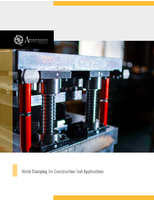NASA awards first stage contract for Ares rockets.
Press Release Summary:
NASA has signed $1.8 billion contract with Alliant Techsystems, known as ATK, located near Brigham City, Utah, for design, development, testing, and evaluation of first stage of Ares I and Ares V launch vehicles. Contract continues work that began on April 17, 2006, and includes delivery of 5 ground static test motors, 2 ground vibration test articles, and 4 flight test stages, including one for Ares I-X test flight. Contract performance period extends through Dec 31, 2014.
Original Press Release:
NASA Awards First Stage Contract for Ares Rockets
WASHINGTON - NASA has signed a $1.8 billion contract with Alliant Techsystems, known as ATK, located near Brigham City, Utah, for the design, development, testing, and evaluation of the first stage of the Ares I and Ares V launch vehicles.
This contract continues work that began on April 17, 2006, and includes delivery of five ground static test motors, two ground vibration test articles and four flight test stages, including one for the Ares I-X test flight.
NASA awarded the cost-plus-award-fee contract to ATK on a sole-source basis. The contract performance period extends through Dec. 31, 2014. First stage boosters for operational missions will be purchased through a separate contract.
ATK and its subcontractors possess the unique engineering capabilities for successful design and development of the first stage of the Ares I crew launch vehicle. The current space shuttle solid rocket booster is the only solid rocket booster manufactured in the United States that possesses both the required capabilities and safety margins necessary for the launch of a human-rated exploration space vehicle. These solid rocket boosters consistently have proven their capabilities and demonstrated reliability needed for the human exploration missions.
The Ares I first stage will be a five-segment solid rocket booster based on the four-segment design used for the shuttle. The basic design will draw on current hardware, facilities and manufacturing equipment qualified for human-rated solid rocket boosters.
The first stage will incorporate modifications to the current booster that are unique to the Ares I architecture to meet higher performance and reliability requirements for the Ares vehicles. Modifications include the additional segment and new solid rocket booster components.
Ares I is an in-line, two-stage rocket that will transport the Orion crew exploration vehicle to low Earth orbit. Orion will accommodate as many as six astronauts. The first stage will consist of the five-segment solid rocket booster. The second, or upper, stage will consist of a J-2X liquid-oxygen, liquid-hydrogen engine, a new upper stage fuel tank and associated avionics.
Ares V will enable NASA to launch a variety of science and exploration payloads, as well as key components, needed to travel to the moon and later to Mars. Ares V, a heavy-lift launch vehicle, is currently projected to use five RS-68 liquid-oxygen, liquid-hydrogen engines mounted below a larger version of the shuttle's external tank and two five-segment, solid-propellant rocket boosters for the first stage. The upper stage will use the same J-2X engine as the Ares I.
The first stage is managed by NASA's Marshall Space Flight Center in Huntsville, Ala., for NASA's Constellation Program.
For information about NASA's Constellation Program, visit: www.nasa.gov/constellation
Beth Dickey/Melissa Mathews
Headquarters, Washington
202-358-2087/1272
beth.dickey-1@nasa.gov, melissa.mathews-1@nasa.gov
Kim Newton
Marshall Space Flight Center, Huntsville, Ala.
256-544-0034
kimberly.d.newton@nasa.gov




